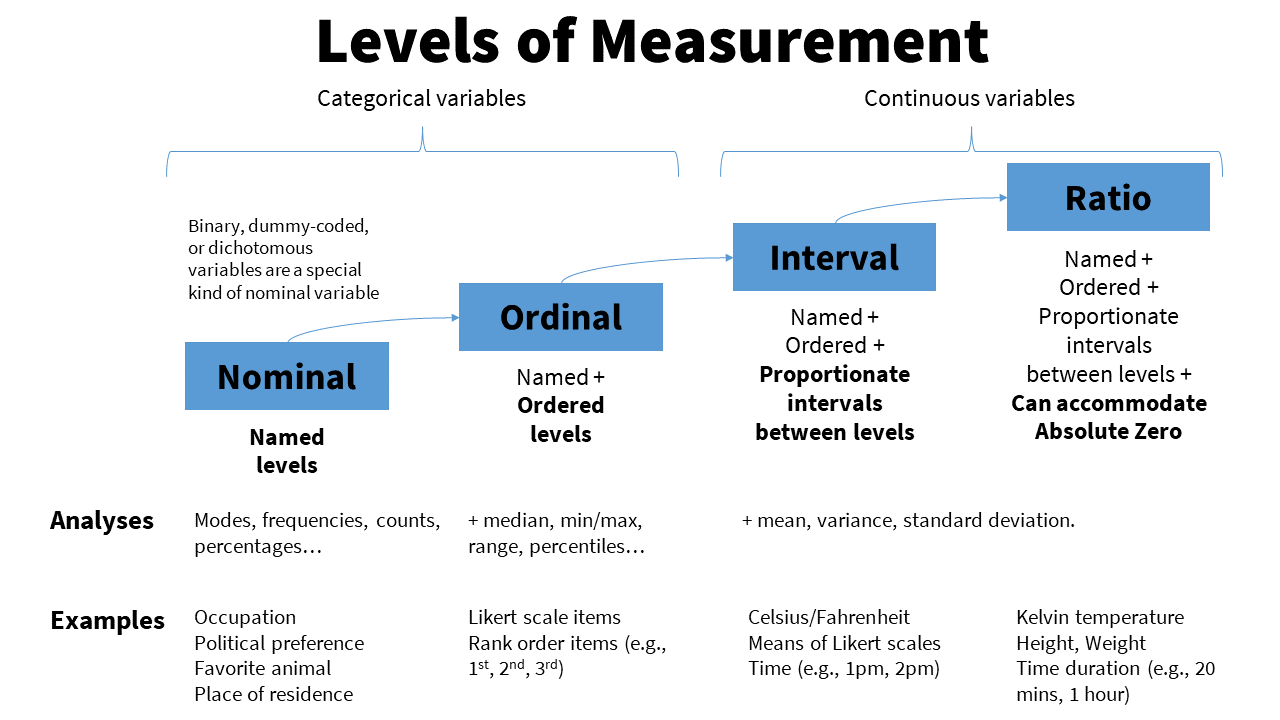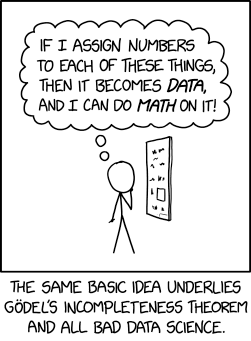2.2 Levels of measurement
This may or may not be refresher material for you, but it is extremely important you are familiar with the four levels of measurement.

Categorical: variables that have categories to the levels, but cannot be analyzed with a mean because the levels are not proportionate. There are two types of categorical variables:
Nominal: a categorical variable in which each level of the variable is named but there is no order to them (e.g., breeds of dogs). Nominal variables can only be analyzed with frequencies, modes, counts, or percentages. Nominal variables with only two levels (generally coded as 0 or 1, although jamovi can handle named levels), we call these special nominal variables as either binary, dummy-coded, or dichotomous nominal variables. For example, binary variables could be coded as yes or no or as absence or presence.
Ordinal: a categorical variable in which each level of the variable is named and there is an order to them (e.g., ranks). We can analyze ordinal variables with frequencies and percentages, like nominal variables, but we can also analyze them using medians, minimum and maximum values, ranges, and percentiles.
Continuous: variables with proportionate intervals between the levels, meaning they can be analyzed with a mean, SD, variance. There are two types of continuous variables (although for the purpose of this course we will simply call them continuous variables):
Interval: a continuous variable that has intervals that are directly proportionate (e.g., the distance between 2-3 is the same as the distance between 5-6). We can analyze interval variables using means, variances, and standard deviations.
Ratio: a continuous variable like an internal variable but can accommodate an absolute zero, meaning a zero is actually possible (e.g., weight, temperature in Kelvin, reaction time). We can also analyze ratio variables with means, variances, and standard deviations, but we can also conduct arithmetic operations like fractions and ratios.
Note that in this class, I won’t ask you to differentiate between interval and ratio levels of measurement because the differences between the two are usually not meaningful in our work. You’ll even find that jamovi doesn’t differentiate between the two, either. Instead, you just need to know whether the variables are continuous, ordinal, or nominal.
Examples of levels of measurement
Confused still on the levels of measurement? Maybe this will help!
One semester, a student asked, “Isn’t time a continuous variable?” To which I responded, “It depends on how it is measured!” If time was measured in a simple pre/post design, such as the start of the semester and the end of the semester, then it’s a nominal variable, and a specific type of nominal variable that we can call binary or dichotomous. If time was measured by month, January through December, then it would be ordinal because January is before (earlier than) February, for example. There is an order to the months, and a calendar that went March, October, April, January, etc. would make no sense. If time was measured as a continuous variable, it could be something like the exact day, exact time, response time, or time remaining.
Here’s another example. Notice that studying can be measured at different levels. Depending on the nature of the question and response options, it might be nominal, ordinal, or continuous! Here’s an example of data at the continuous, ordinal, and nominal level.
| Name | Study_Continuous | Study_Ordinal | Study_Nominal |
|---|---|---|---|
| Name (Character) | Hours studied per day | Likert scale of amount of studying | Whether or not they study every day |
| Jesus | 5.0 | A great deal | Yes |
| Nicky | 4.5 | A great deal | Yes |
| Bradford | 3.2 | A moderate amount | Yes |
| Sylvia | 1.7 | A small amount | Yes |
| Martha | 0.2 | Rarely | Yes |
| Lillian | 0.0 | Never | No |
| Trayvon | 0.0 | Never | No |
We can make any continuous variable into an ordinal and nominal variable and any ordinal variable into a nominal variable. But if we have a nominal variable we cannot make it ordinal, nor can we make an ordinal variable continuous. In other words, continuous variables contain more information than categorical variables. Often, we want to avoid losing information and so we should aim to keep the variable at the highest level of measurement.
Because continuous variables have more information, we want to avoid doing things like mean or median splits or “collapsing” categories when you can. A mean or median split, which involves finding the mean or median value and splitting the data so it’s above the mean/median or below the mean/median, is making a continuous variable as nominal, which is removing information. Collapsing categories may also further reduce the information.
Another thing to keep in mind is that just because we put numbers to something does not necessarily make it continuous! Be careful and think critically. If I said cat = 1, dog = 2, and frog = 3 it doesn’t make it an ordinal or continuous variable.
